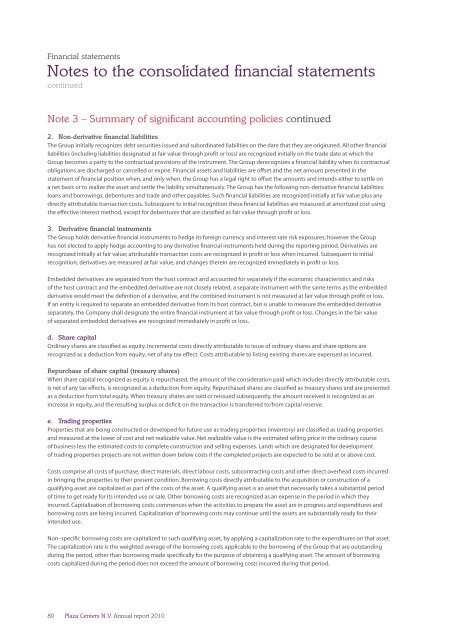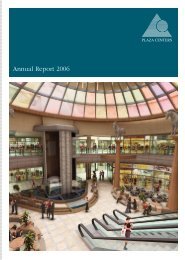Annual report 2010 - plazacenters
Annual report 2010 - plazacenters
Annual report 2010 - plazacenters
You also want an ePaper? Increase the reach of your titles
YUMPU automatically turns print PDFs into web optimized ePapers that Google loves.
Financial statements<br />
Notes to the consolidated financial statements<br />
continued<br />
Note 3 – Summary of significant accounting policies continued<br />
2. Non-derivative financial liabilities<br />
The Group initially recognizes debt securities issued and subordinated liabilities on the date that they are originated. All other financial<br />
liabilities (including liabilities designated at fair value through profit or loss) are recognized initially on the trade date at which the<br />
Group becomes a party to the contractual provisions of the instrument. The Group derecognizes a financial liability when its contractual<br />
obligations are discharged or cancelled or expire. Financial assets and liabilities are offset and the net amount presented in the<br />
statement of financial position when, and only when, the Group has a legal right to offset the amounts and intends either to settle on<br />
a net basis or to realize the asset and settle the liability simultaneously. The Group has the following non-derivative financial liabilities:<br />
loans and borrowings, debentures and trade and other payables. Such financial liabilities are recognized initially at fair value plus any<br />
directly attributable transaction costs. Subsequent to initial recognition these financial liabilities are measured at amortized cost using<br />
the effective interest method, except for debentures that are classified as fair value through profit or loss.<br />
3. Derivative financial instruments<br />
The Group holds derivative financial instruments to hedge its foreign currency and interest rate risk exposures; however the Group<br />
has not elected to apply hedge accounting to any derivative financial instruments held during the <strong>report</strong>ing period. Derivatives are<br />
recognized initially at fair value; attributable transaction costs are recognized in profit or loss when incurred. Subsequent to initial<br />
recognition, derivatives are measured at fair value, and changes therein are recognized immediately in profit or loss.<br />
Embedded derivatives are separated from the host contract and accounted for separately if the economic characteristics and risks<br />
of the host contract and the embedded derivative are not closely related, a separate instrument with the same terms as the embedded<br />
derivative would meet the definition of a derivative, and the combined instrument is not measured at fair value through profit or loss.<br />
If an entity is required to separate an embedded derivative from its host contract, but is unable to measure the embedded derivative<br />
separately, the Company shall designate the entire financial instrument at fair value through profit or loss. Changes in the fair value<br />
of separated embedded derivatives are recognized immediately in profit or loss.<br />
d. Share capital<br />
Ordinary shares are classified as equity. Incremental costs directly attributable to issue of ordinary shares and share options are<br />
recognized as a deduction from equity, net of any tax effect. Costs attributable to listing existing shares are expensed as incurred.<br />
Repurchase of share capital (treasury shares)<br />
When share capital recognized as equity is repurchased, the amount of the consideration paid which includes directly attributable costs,<br />
is net of any tax effects, is recognized as a deduction from equity. Repurchased shares are classified as treasury shares and are presented<br />
as a deduction from total equity. When treasury shares are sold or reissued subsequently, the amount received is recognized as an<br />
increase in equity, and the resulting surplus or deficit on the transaction is transferred to/from capital reserve.<br />
e. Trading properties<br />
Properties that are being constructed or developed for future use as trading properties (inventory) are classified as trading properties<br />
and measured at the lower of cost and net realizable value. Net realizable value is the estimated selling price in the ordinary course<br />
of business less the estimated costs to complete construction and selling expenses. Lands which are designated for development<br />
of trading properties projects are not written down below costs if the completed projects are expected to be sold at or above cost.<br />
Costs comprise all costs of purchase, direct materials, direct labour costs, subcontracting costs and other direct overhead costs incurred<br />
in bringing the properties to their present condition. Borrowing costs directly attributable to the acquisition or construction of a<br />
qualifying asset are capitalized as part of the costs of the asset. A qualifying asset is an asset that necessarily takes a substantial period<br />
of time to get ready for its intended use or sale. Other borrowing costs are recognized as an expense in the period in which they<br />
incurred. Capitalization of borrowing costs commences when the activities to prepare the asset are in progress and expenditures and<br />
borrowing costs are being incurred. Capitalization of borrowing costs may continue until the assets are substantially ready for their<br />
intended use.<br />
Non–specific borrowing costs are capitalized to such qualifying asset, by applying a capitalization rate to the expenditures on that asset.<br />
The capitalization rate is the weighted average of the borrowing costs applicable to the borrowing of the Group that are outstanding<br />
during the period, other than borrowing made specifically for the purpose of obtaining a qualifying asset. The amount of borrowing<br />
costs capitalized during the period does not exceed the amount of borrowing costs incurred during that period.<br />
80<br />
Plaza Centers N.V. <strong>Annual</strong> <strong>report</strong> <strong>2010</strong>








